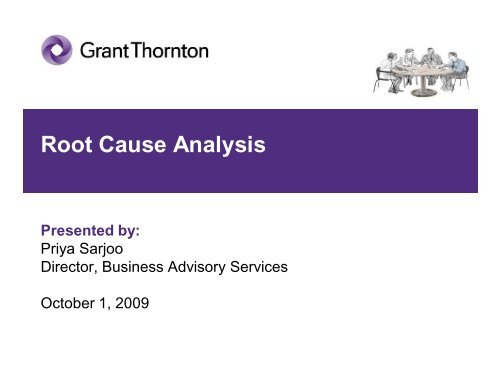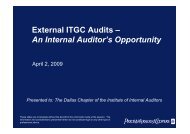CAST: Root Cause Analysis - IIA Dallas Chapter
CAST: Root Cause Analysis - IIA Dallas Chapter
CAST: Root Cause Analysis - IIA Dallas Chapter
Create successful ePaper yourself
Turn your PDF publications into a flip-book with our unique Google optimized e-Paper software.
Agenda• Definition• Methodologies• Problem identification• Process understanding• <strong>Cause</strong> identification• Data collection & analysis• Corrective action© Grant Thornton LLP. All rights reserved.
Definition• <strong>Root</strong> <strong>Cause</strong> <strong>Analysis</strong>:–Component of a corrective action process wherebyfailures or non-conformances are identified, causes arediagnosed and actions are taken to prevent recurrence–Focuses on identifying possible causes, collecting andanalyzing data and determining actual cause(s)–A generic skill that can be applied to nearly any type ofproblem© Grant Thornton LLP. All rights reserved.1
Problem identification (continued)• Example:–Effect: Increase in number of cancer diagnoses–Possible <strong>Cause</strong>s:•Increase in number of individuals tested•More precise testing techniques•Increased incidences of cancer•Others…© Grant Thornton LLP. All rights reserved.4
Problem identification (continued)• Develop a thorough, succinct description which includes thefollowing:–What?–Where?–Who?–When?–How much?• Do not include or imply a cause© Grant Thornton LLP. All rights reserved.6
<strong>Cause</strong> identification (continued)© Grant Thornton LLP. All rights reserved.8
<strong>Cause</strong> identification (continued)• Analyze to identify possible causes• Narrow causes down by identifying theones most likely to have caused theerror–Conduct a sanity check–Is it logical?–Is it supported by the data?–Is it probable?© Grant Thornton LLP. All rights reserved.13
<strong>Cause</strong>-and-effect analysis• Drill down from symptoms to system cause–The “5 whys” process•Keep asking why something happened,until you get to a point where you cantake action to correct the underlyingsystem cause© Grant Thornton LLP. All rights reserved.11
<strong>Cause</strong>-and-effect analysis (continued)SymptomHigh Levelsof ObsoleteInventoryPhysical<strong>Cause</strong>InadequateInventoryManagementWhy?Slow SalesWhy?System<strong>Cause</strong>PoorVisibility toInventoryLevelsWhy?InsufficientlyTrained StaffPricedIncorrectly© Grant Thornton LLP. All rights reserved.12
<strong>Cause</strong>-and-effect analysis (continued)• Drill down from symptoms to system cause (cont’d)–The “4 Ps” processPeopleInsufficient trainingPlaceComputer problemHighobsoleteinventoryUn-reviewed calculationsNo monthly validationProceduresPolicies© Grant Thornton LLP. All rights reserved.12
Data collection• Understand cause-and-effect• Understand the process variables and howthey can be measured• Understand the data and how it can begathered• Decide on analysis methods• Gather the data© Grant Thornton LLP. All rights reserved.15
Data collection methods• Interview• Observation• Data review• Scientific techniques© Grant Thornton LLP. All rights reserved.16
Data analysis• Ensure the correct data is collected (i.e. data is pertinent tothe issue under review)• Determine the expected outcome• Analyze the data• Compare to expected outcome© Grant Thornton LLP. All rights reserved.17
Data analysis (continued)• Obsolete inventory example:–Understand standards or established procedures forinventory management–Develop process flowchart showing inventory inputs,processes and outputs–Identify data to be collected and analyzed–Collect inventory aging by SKU, dollars and quantity–Re-perform inventory reserve calculation–Compare to existing reserve calculation–Identify inconsistencies© Grant Thornton LLP. All rights reserved.18
Corrective action• Focus resources on where they would be best spent–Identify one problem/reason/cause which may have thelargest impact (e.g. dollars, time, re-work, exposure, etc.)–Focus efforts on resolving the cause with the largestimpact© Grant Thornton LLP. All rights reserved.14
Questions© Grant Thornton LLP. All rights reserved.19









